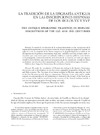Identificador persistente para citar o vincular este elemento:
https://accedacris.ulpgc.es/jspui/handle/10553/11033
| Campo DC | Valor | idioma |
|---|---|---|
| dc.contributor.author | Ramírez-Sánchez, Manuel | en_US |
| dc.date.accessioned | 2013-11-29T10:16:46Z | - |
| dc.date.accessioned | 2018-03-15T14:25:43Z | - |
| dc.date.available | 2013-11-29T10:16:46Z | - |
| dc.date.available | 2018-03-15T14:25:43Z | - |
| dc.date.issued | 2012 | en_US |
| dc.identifier.issn | 0213-2095 | en_US |
| dc.identifier.other | WoS | - |
| dc.identifier.uri | https://accedacris.ulpgc.es/handle/10553/11033 | - |
| dc.description.abstract | Se estudia la introducción de la escritura humanística en las inscripciones de la España del Renacimiento y su evolución a través de diversos programas epigráficos durante los siglos XV y XVI. La irrupción de las litterae antiquae en la epigrafía hispánica se realizó en las inscripciones de los primeros monumentos funerarios realizados conforme al nuevo estilo renacentista, pero muy pronto pasó a ser utilizada también en contextos públicos, como elemento de propaganda y autorrepresentación de la dinastía de los Austrias, así como por algunos miembros de la Nobleza, que vieron en la recuperación de los modelos de la tradición clásica un elemento más al servicio de la representación del poder, a través de la imagen y lo escrito. | en_US |
| dc.description.abstract | We study the introduction of Humanistic writing in the Spanish Renaissance inscriptions and its development across the various epigraphic programmes during the 15th and 16th centuries. The first signs of the litterae antiquae in Hispanic epigraphy are found in the first Renaissance-style funerary monuments. However, it was soon used in public contexts as a propaganda and self-representation element by the dynasty of the Austrias, as well as some of the nobility, which saw in the recovery of the classical tradition models, a new way of representing power through image and script. | en_US |
| dc.language | spa | en_US |
| dc.relation.ispartof | Veleia | en_US |
| dc.source | Veleia [ISSN 0213-2095], n. 29, p. 255-277, (2012) | en_US |
| dc.subject | 55 Historia | en_US |
| dc.subject | 550503 Epigrafía | en_US |
| dc.subject.other | Humanismo | en_US |
| dc.subject.other | Epigraphy | en_US |
| dc.subject.other | Renacimiento | en_US |
| dc.subject.other | Humanism | en_US |
| dc.subject.other | Renaissance | en_US |
| dc.subject.other | Spain | en_US |
| dc.subject.other | España | en_US |
| dc.title | La tradición de la epigrafía antigua en las inscripciones hispanas de los siglos XV y XVI | en_US |
| dc.title.alternative | The Antique Epigraphic Tradition In Hispanic Inscriptions Of The 15Th And 16Th Centuries | en_US |
| dc.type | info:eu-repo/semantics/article | en_US |
| dc.type | Article | en_US |
| dc.identifier.isi | 000438722500018 | - |
| dc.identifier.absysnet | 692805 | - |
| dc.identifier.eissn | 2444-3565 | - |
| dc.description.lastpage | 277 | en_US |
| dc.identifier.issue | 29 | - |
| dc.description.firstpage | 255 | en_US |
| dc.investigacion | Artes y Humanidades | en_US |
| dc.rights.accessrights | info:eu-repo/semantics/openAccess | - |
| dc.type2 | Artículo | en_US |
| dc.contributor.daisngid | 12171765 | - |
| dc.description.numberofpages | 23 | en_US |
| dc.utils.revision | Sí | en_US |
| dc.contributor.wosstandard | WOS:Sanchez, MR | - |
| dc.date.coverdate | 2012 | en_US |
| dc.identifier.ulpgc | Sí | en_US |
| dc.contributor.buulpgc | BU-HUM | en_US |
| dc.description.esci | ESCI | |
| dc.description.erihplus | ERIH PLUS | |
| item.fulltext | Con texto completo | - |
| item.grantfulltext | open | - |
| crisitem.author.dept | GIR IATEXT: Patrimonio cultural: textos, materialidades y memorias | - |
| crisitem.author.dept | IU de Análisis y Aplicaciones Textuales | - |
| crisitem.author.dept | Departamento de Ciencias Históricas | - |
| crisitem.author.orcid | 0000-0002-4935-7313 | - |
| crisitem.author.parentorg | IU de Análisis y Aplicaciones Textuales | - |
| crisitem.author.fullName | Ramírez Sánchez, Manuel Enrique | - |
| Colección: | Artículos | |
Citas de WEB OF SCIENCETM
Citations
1
actualizado el 25-feb-2024
Visitas 5
392
actualizado el 16-ene-2026
Descargas
214
actualizado el 16-ene-2026
Google ScholarTM
Verifica
Comparte
Exporta metadatos
Este elemento está sujeto a una licencia Licencia Creative Commons

